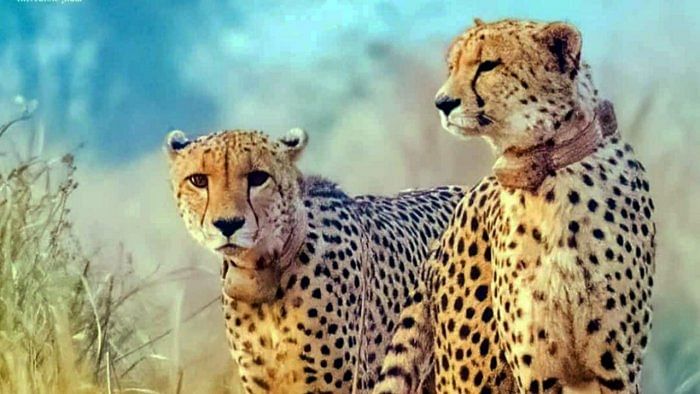
Cheetahs at the Kuno National Park in Sheopur district, MP.
Credit: PTI Photo
New Delhi: India lost yet another imported cheetah on Tuesday as one of the Namibian big cats, Shaurya, died at Kuno National Park within hours of being spotted with signs of "in-coordination and staggering gait," officials said.
In a brief statement, the Madhya Pradesh Forest Department said the cause of death would be ascertained after a post-mortem examination.
This marks the seventh death among the big cats brought from Namibia and South Africa by the Union government to repopulate the central Indian landscape with African cheetahs, decades after their Asiatic cousins were wiped out from India.
If one counts the death of three cubs on a single day in the peak of summer last May, the toll rises to ten.
“Around 11 am, incoordination and staggering gait was observed by the tracking team following which the animal was tranquilized and weakness was found. Following this the animal was revived but complications arose post revival and the animal failed to respond to CPR,” says the statement.
Last month, four animals – Agni, Vayu, Veera, and Pavan - were released in safari while the rest, including one of the cubs born last year, remained in the enclosure. Earlier this month, another Namibian cheetah Aasha gave birth to three cubs.
Wildlife experts had repeatedly warned against keeping the animals in enclosures for a long time, but the forest officials preferred such an approach after facing challenges like unexpected skin infections in the monsoon season.
“Numerous adult cheetahs have undergone repeated chemical immobilization for various purposes. These reasons include dispersing too far from Kuno National Park, suspected disease exposure during the monsoon season, injuries sustained in territorial conflicts, coalition management, and their eventual release from enclosures into the wild,” said Bengaluru-based ecologist Arjun Gopalswamy.
“According to news reports, only two cheetahs currently roam freely in Kuno, while the remaining cheetahs are confined either in hunting or quarantine bomas. These circumstances are recognized to impose significant stress on the cheetahs,” Gopalswamy, the founder director of Carnassials Global, told DH.
In September 2022, India brought eight cheetahs from Namibia, and the first two were released in the enclosure by Prime Minister Narendra Modi. In February 2023, another 12 were brought from South Africa. New Delhi now looks at Kenya as a potential source for the next batch of imported cheetahs.
On the cheetah deaths at Kuno, the National Tiger Conservation Authority told the Supreme Court last year that all the mortality at Kuno was due to “natural causes” and none of the cheetahs died due to “unnatural reasons like poaching, snaring, poisoning, road-hits, and electrocution.”
“The NTCA has no reason to believe that the mortalities were caused on account of any inherent unsuitability at Kuno,” the authority informed the top court, noting that even in the non-introduced population, the survival rate is just about 50%.
